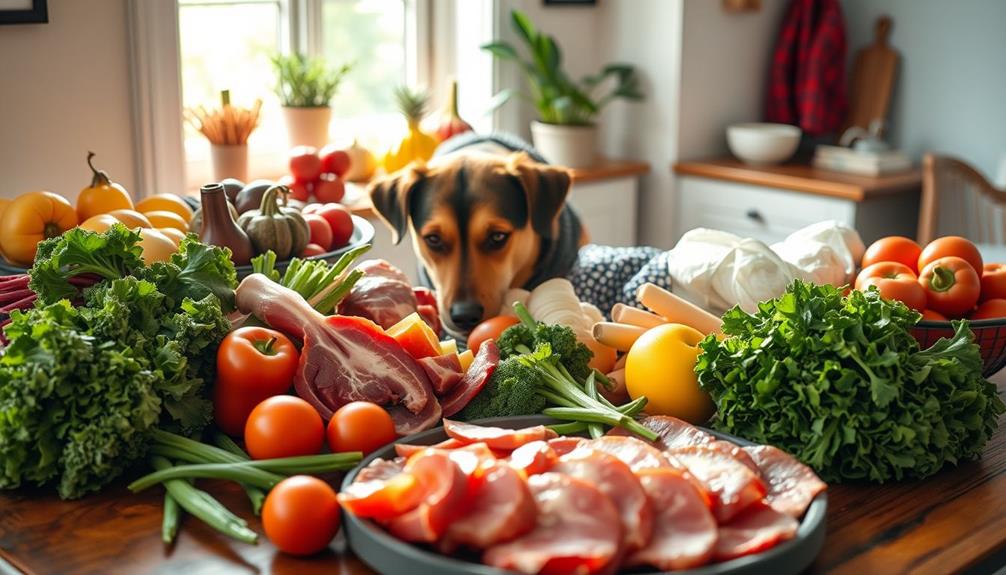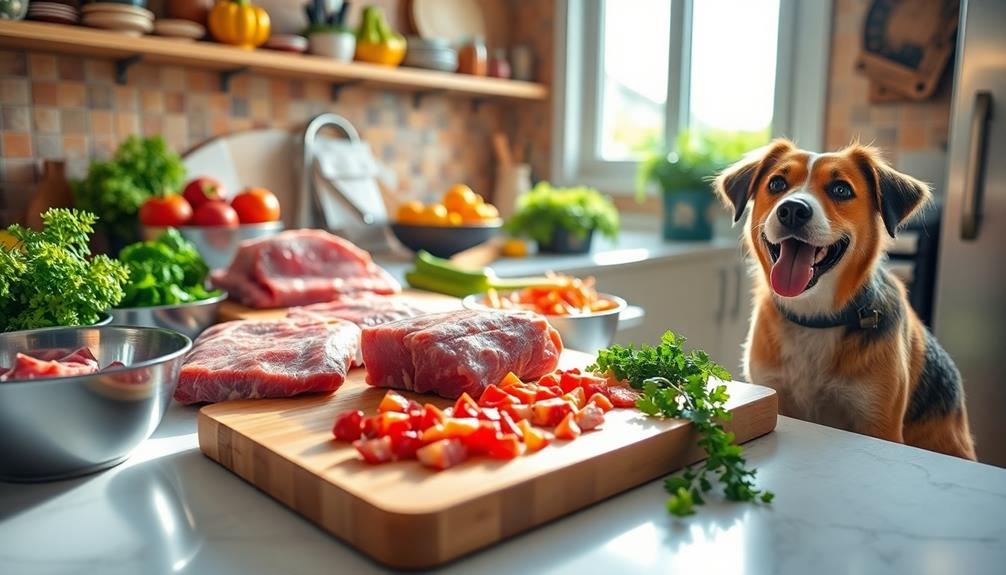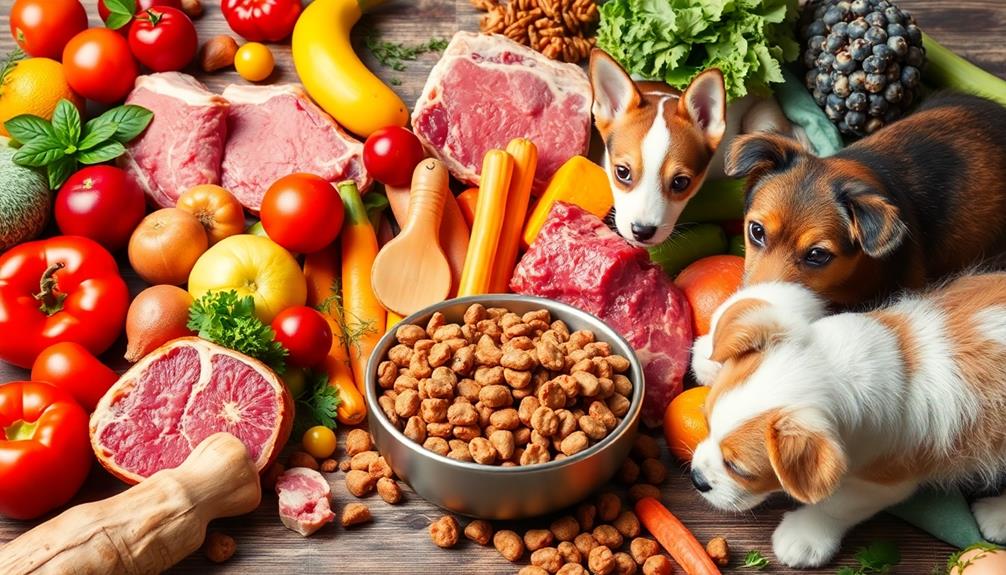Traveling with pets on a raw food diet needs some preparation to keep your furry friend healthy and happy. Start by packing extra raw food and researching pet-friendly places with refrigeration. Pre-portion meals for easy access and consider the cooler size to maintain safe temperatures. Monitor their feeding schedule closely to minimize stress and avoid digestive issues. Stay flexible and adjust their meals if appetite changes occur. Maintain hygiene while handling raw food to prevent contamination. For tips on finding local resources and ensuring your pet's diet remains balanced, there's more to explore.
Key Takeaways
- Pre-portion raw meals into airtight containers to ensure easy feeding and minimize spoilage during travel.
- Use high-quality coolers with ice packs to maintain safe temperatures for raw food below 40°F.
- Research pet-friendly accommodations with refrigeration options to store raw food safely.
- Monitor your dog's appetite and adjust feeding schedules based on travel routines and environmental changes.
- Plan for local pet food suppliers along your route for potential replenishment of raw food supplies.
Planning for Pet Travel
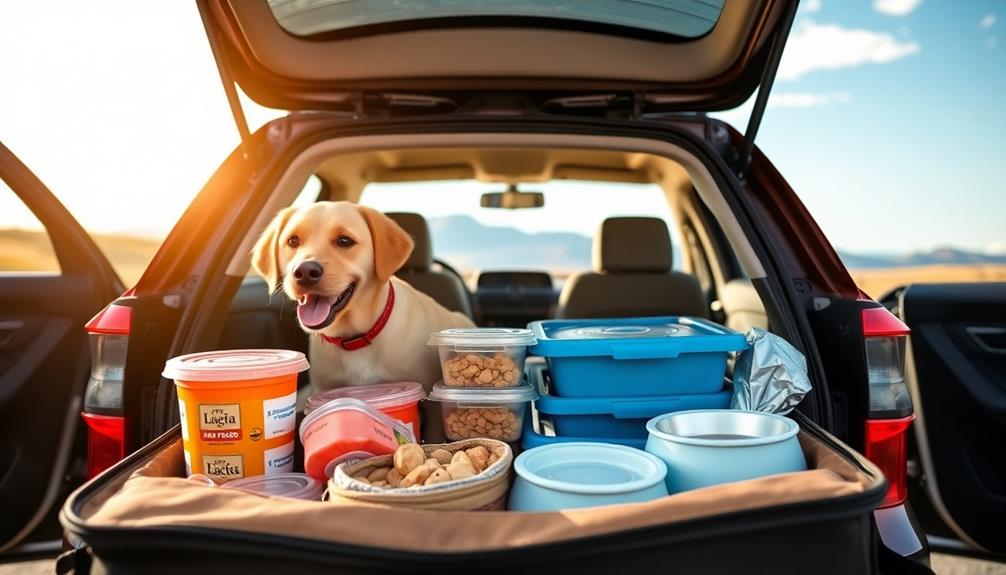
Traveling with your pet on a raw food diet requires careful planning to guarantee a smooth journey. Start by determining your dog's daily food intake and pack an extra day's worth of raw dog food. This precaution guarantees you're prepared for any emergencies or delays.
Research pet-friendly accommodations along your route that offer refrigeration or allow you to store food properly, preventing spoilage.
Pre-portion meals into airtight containers or resealable bags to make feeding your dog easy and efficient during the trip. This minimizes food waste and keeps your travel hassle-free.
When packing, calculate the size of your cooler based on how much raw food you need. Confirm it's well-insulated to maintain safe temperatures, as raw dog food requires proper storage to prevent any health issues.
Lastly, familiarize yourself with local pet food suppliers along your travel route. This way, you can replenish your dog's food supply if necessary.
Food Options for Road Trips

Finding food options for road trips with your pet on a raw food diet can be straightforward with the right preparations. One effective choice is homemade frozen raw food, which you should prepare at least seven days before your trip to eliminate any potential tapeworms.
If you're short on time, consider store-bought raw frozen food; just make certain you select reputable brands that offer fresh-smelling products.
Another viable option is dehydrated food. Whether homemade or store-bought, freeze-dried meals are lightweight, have a long shelf life, and are easy to rehydrate. This makes them particularly practical for maintaining a raw diet while on the road.
If you prefer fresh raw food, you can source previously frozen meat from grocery stores along your route, but be certain you have a plan for proper storage to avoid spoilage.
Glass jar preserves can also serve as a safe alternative, although you should limit their use to 2-4 weeks due to the potential loss of nutritional value.
With these options, you can keep your pet's raw food diet intact during your travels.
Safe Storage Solutions

When traveling with your pet on a raw food diet, proper storage is essential for keeping their meals safe and fresh.
Invest in a high-quality cooler with thick insulation and ice packs to guarantee the food stays frozen for as long as possible.
Additionally, consider emergency food options that can supplement their diet in case of any unexpected delays.
Cooler Storage Techniques
To guarantee your pet's raw food stays safe during your journey, a well-insulated cooler is essential. You should use ice packs to maintain safe temperatures, ideally below 40°F, preventing spoilage. Incorporating healthy snacks for your pet can help keep them satisfied during the trip.
Store the raw foods in airtight containers or resealable bags within the cooler to minimize exposure to air and moisture, which can lead to contamination.
When packing, place the first day's meals on top for easy access. This helps avoid thawing other food unnecessarily, assuring they remain frozen or cold for as long as possible. Regularly monitor the cooler temperature and aim to replenish ice or ice packs daily, especially on longer trips, to maintain food safety.
If you're planning an extended journey, consider using dry ice, as it can keep food frozen for a longer period. Just remember to handle it with care and guarantee proper ventilation.
This way, your cooler storage technique will help you keep your pet's raw foods fresh and safe, allowing for a worry-free travel experience together.
Emergency Food Options
Packing extra food is a smart move for any journey with your pet, especially when following a raw food diet. Always bring an extra day's worth of raw food to safeguard against travel delays or unexpected situations.
To keep your raw food fresh during long trips, consider using dry ice or high-quality coolers with ice packs. These solutions help maintain safe temperatures, guaranteeing your pet's diet remains intact. Additionally, opting for high-quality protein sources can enhance your pet's nutrition while traveling.
Before you hit the road, research local pet stores along your travel route. This way, you can find potential emergency food options if you need to restock.
Additionally, freeze-dried raw food can be a fantastic lightweight and shelf-stable choice. All it requires is water for rehydration, making it ideal for traveling.
Don't forget to keep a log of your food supplies and monitor expiry dates. This practice will help you avoid running out of food and guarantee proper storage throughout your journey.
With these strategies, you can confidently navigate the challenges of traveling with pets on a raw diet, knowing you're prepared for any emergency.
Feeding Schedule Management

When you travel with your pet, keeping a consistent feeding schedule is essential to minimize stress and guarantee they stay on track.
You'll want to monitor their appetite closely, adjusting portion sizes based on their activity level and any changes in their environment.
Regular Feeding Times
Establishing regular feeding times during travel is essential for keeping your pet calm and comfortable. A consistent schedule not only minimizes stress but also provides a sense of routine amid the changes in environment.
When you're on the road, sticking to regular feeding helps your furry friend adjust smoothly to raw feeding.
Here are some tips to maintain a feeding schedule while traveling:
- Set specific meal times: Stick to the same times as you'd at home.
- Adjust portion sizes: Tailor the amount based on your travel duration.
- Monitor appetite: If your pet's appetite decreases, consider smaller, more frequent meals.
- Keep a feeding log: Document times and behaviors to spot any patterns.
- Stay flexible: Be ready to adapt to your pet's needs during the journey.
Consistency in feeding schedules aids digestion and can prevent gastrointestinal upset, especially when introducing new food options or routines.
Portion Control Strategies
Maintaining portion control while traveling with your pet is essential for their health and comfort. To establish a consistent feeding schedule, first determine your dog's daily food intake based on their size and activity level. This will help you decide how much raw dog food to prepare for the trip.
Before you hit the road, pre-portion meals into individual servings. This not only simplifies feeding but also guarantees you're providing accurate portions throughout the journey. Use a travel-friendly container to keep these portions organized and easily accessible during feeding times.
Be prepared to adjust the feeding amounts if your travel routine changes. Keep an eye on your dog's appetite and activity levels to guarantee they're getting the nutrition they need.
It's a good idea to maintain a log of feeding times and quantities throughout your travels. This way, you can identify patterns and make necessary adjustments for future trips, guaranteeing that portion control remains a priority.
Monitor Appetite Changes
Monitoring your dog's appetite during travel is vital, as changes in routine and environment can affect their food intake.
To guarantee your furry friend stays healthy and happy on the road, it's important to stay attentive to their eating habits.
Here are some tips to help you monitor their appetite effectively:
- Keep a log of feeding times and behaviors to spot any patterns or issues.
- Offer smaller, more frequent meals if your dog shows disinterest in their food.
- Watch for signs of digestive upset, like vomiting or diarrhea, and adjust their food accordingly.
- Maintain a consistent feeding schedule, even while on the go, to reduce stress.
- Be flexible and ready to change the type or amount of food based on your dog's responses.
Health and Safety Precautions
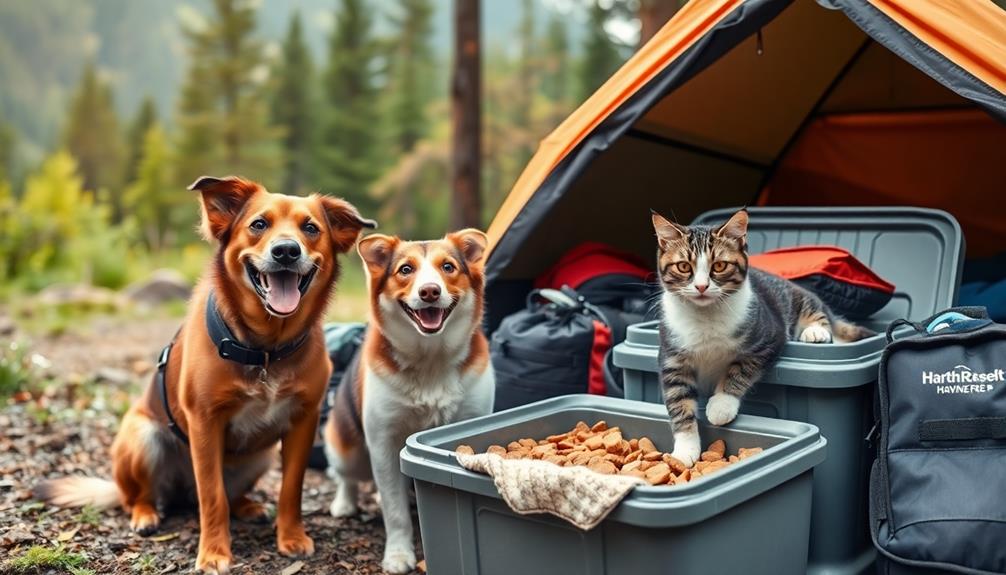
When traveling with pets on a raw food diet, prioritizing health and safety precautions is essential. First, make certain all raw food is properly frozen for at least seven days before your trip. This step eliminates the risk of tapeworms, keeping your dogs safe.
Use separate coolers for pet food and human food to avoid cross-contamination and maintain food safety during transport. Regularly monitor the temperature of the coolers to guarantee the raw food stays frozen or cold, ideally below 40°F (4°C), to prevent spoilage.
After handling raw food, clean and disinfect preparation surfaces and utensils thoroughly to minimize the risk of bacterial transfer to both humans and pets.
It's also wise to always carry a first aid kit specifically for dogs. This kit should include items for potential digestive issues that could arise from dietary changes during your travels.
Nutritional Considerations
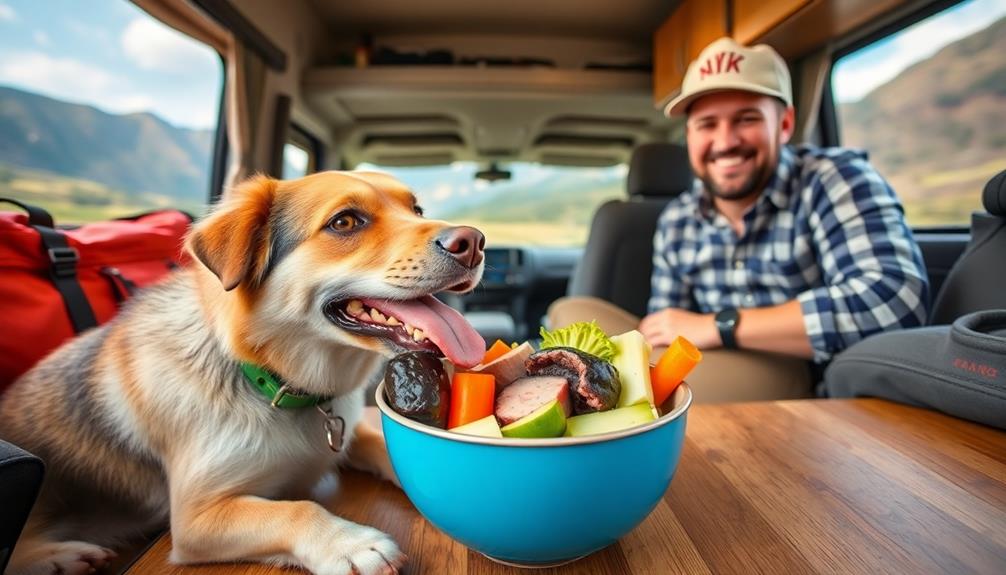
When traveling with your pet on a raw food diet, it's crucial to guarantee they're getting a balanced diet.
You should aim for a mix of meat, organ meat, and bone to provide the necessary nutrients.
Additionally, consider incorporating supplements like omega-3s and probiotics to support their health during the journey.
Essential Nutritional Supplements
Traveling with pets on raw food diets requires careful attention to their nutritional needs, especially when it comes to supplements.
These supplements are essential to maintain your pet's health and to counteract any deficiencies that may arise due to travel stress.
Here are some important supplements you should consider:
- Fermented probiotics and prebiotics: These support digestive health and enhance nutrient absorption.
- Omega-3 fatty acids: Critical for reducing inflammation and supporting brain and nerve health, particularly for active pets.
- Plant-based minerals: They provide essential nutrients that might be missing in a raw food diet.
- Amino acids: Significant for overall health and can be lacking in raw food diets.
- Veterinary consultations: Regular check-ins can help you tailor the right supplements based on your dog's specific health needs.
Balanced Diet Importance
Maintaining a balanced diet for your pet on a raw food regimen is crucial for their overall health and well-being. A raw fed dog needs the right proportions of proteins, fats, carbohydrates, vitamins, and minerals to thrive. Important fatty acids like omega-3 and omega-6 are essential for reducing inflammation and guaranteeing a healthy coat.
Here's a quick overview of key components for a balanced diet:
| Nutrient Type | Importance |
|---|---|
| Proteins | Build and repair tissues, source of energy |
| Organ Meats | Provide crucial nutrients like vitamin A and B vitamins |
| Fruits & Vegetables | Supply additional vitamins, antioxidants, and fiber |
Incorporating organ meats into your dog's diet fills nutritional gaps often found in muscle meat alone. Don't forget to include raw fruits and vegetables for a well-rounded profile. Regularly consulting with a veterinarian or a pet nutritionist can help you guarantee your raw fed dog is getting everything they need. By paying attention to these nutritional considerations, you'll promote a healthier, happier life for your furry companion while traveling!
Supplements for Travel
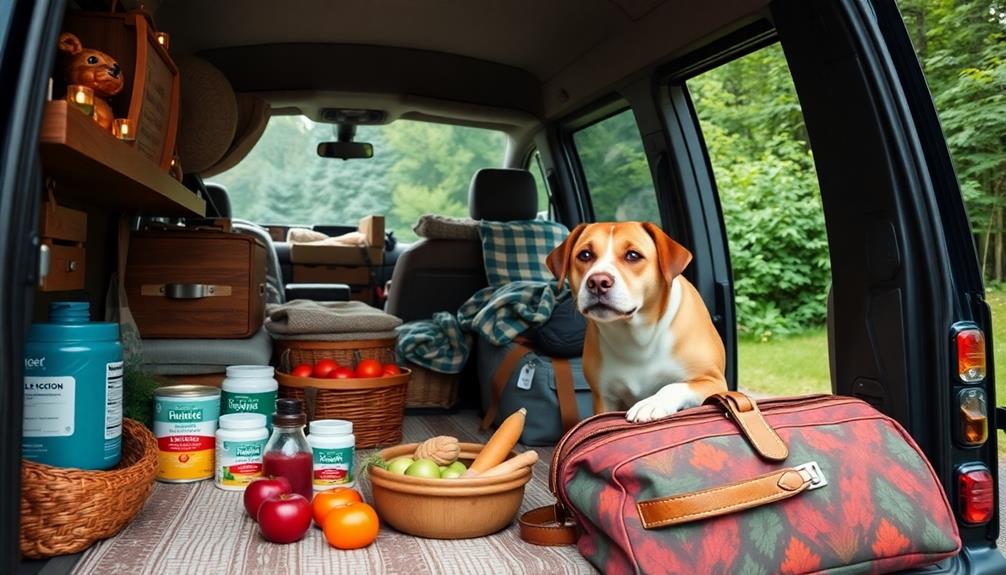
A well-chosen selection of supplements can make all the difference for pets on the go. Traveling can be stressful for pets, so it's crucial to support their health with the right supplements.
Consider integrating the following into your pet's travel routine to maximize their health benefits:
- Fermented probiotics and prebiotics for gut health and digestion.
- Omega-3 oils to promote anti-inflammatory effects, supporting joints and brain health.
- Naturally fermented vitamins to boost the immune system in new environments.
- Organ support supplements for overall vitality during travels.
- A balanced supplement regimen known as the "Fab4" to maintain energy levels.
Don't forget that regular consultations with your veterinarian are important. They can help tailor a supplement plan that meets your pet's specific needs while traveling.
By prioritizing these supplements, you guarantee that your furry friend stays healthy and happy, no matter where the journey takes you.
Always keep your pet's well-being in mind, as a little preparation can lead to smoother travels and a more enjoyable experience for both of you.
Handling Raw Food Safely
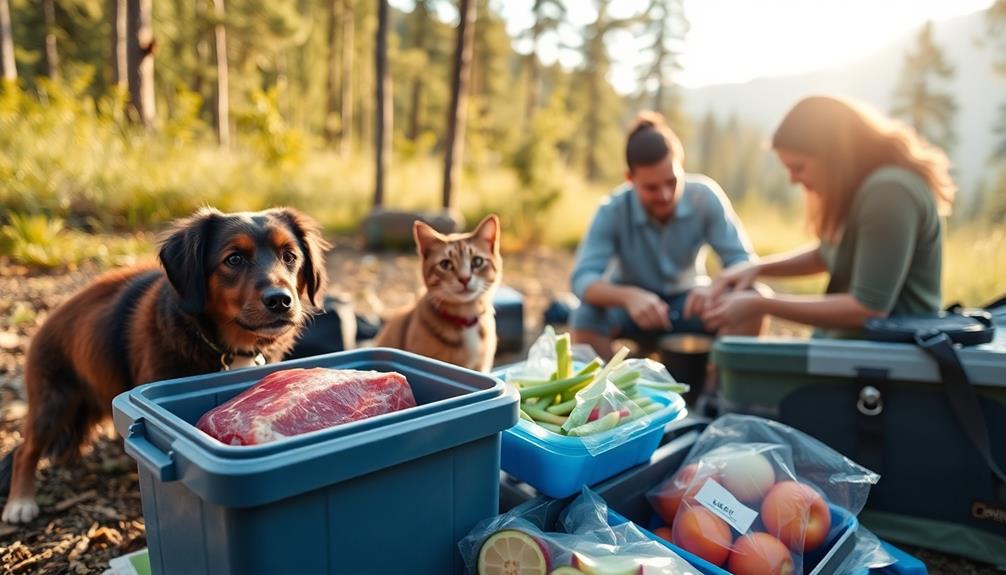
When you're on the move with your pet, handling their raw food safely is just as important as keeping them healthy with the right supplements.
Start by using separate containers for storing and transporting raw food to prevent cross-contamination with your meals. Before and after preparing their raw food, confirm all surfaces and utensils are thoroughly cleaned and disinfected to minimize the risk of bacterial transfer.
Temperature control is essential, too. Keep the raw food frozen or refrigerated, and use coolers with ice packs while traveling. Regularly monitor the cooler's temperature to maintain safety.
Always wash your hands thoroughly with soap and water after handling raw food to reduce the chance of spreading pathogens.
Adhere to safe food handling guidelines, such as keeping raw food separate from cooked food and avoiding leaving it at room temperature for extended periods. This practice helps confirm the health and safety of both your pet and yourself.
Finding Local Resources
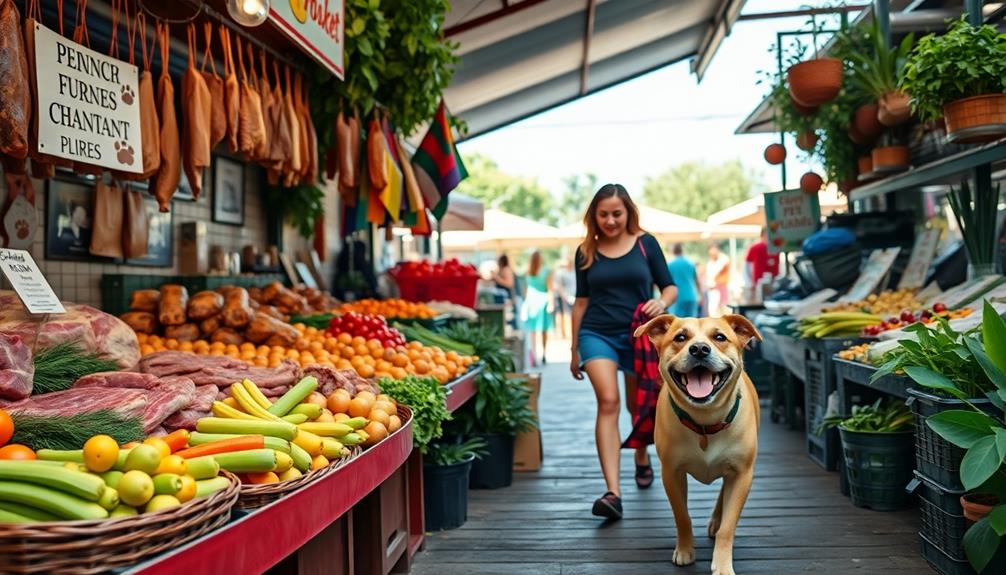
Finding local resources for your pet's raw food diet can make travel much easier and stress-free.
When you're away from home, it's crucial to know where to find quality raw food options for your furry friend.
Here are some tips to help you locate the right resources:
- Research local pet stores or specialty shops that carry reputable raw food brands.
- Use websites and apps that list pet-friendly businesses, including those that sell raw food diets.
- Connect with local pet owner communities through social media groups or forums for recommendations on raw food suppliers.
- Check out farmers' markets or local butcher shops for fresh, high-quality meat suitable for a raw food diet.
- Use GPS or mapping services to find veterinary clinics that might sell raw food products or can suggest local suppliers.
Adjusting to Dietary Changes
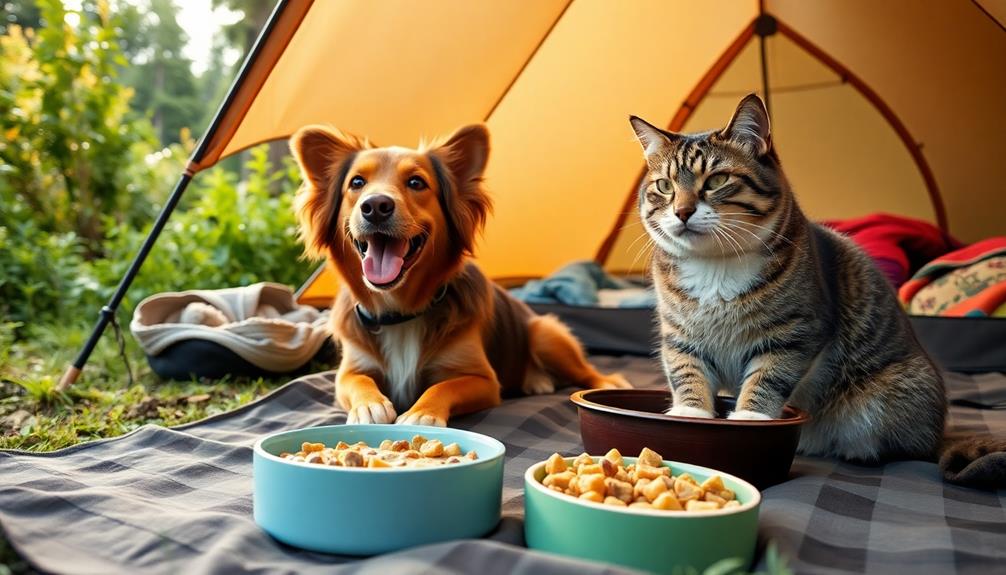
Locating the right resources for your pet's raw food diet is just the first step in guaranteeing a smooth travel experience. As you adjust to dietary changes, it's vital to gradually introduce any new food items over 7-10 days. This slow shift minimizes digestive upset, especially when switching to a different raw food source.
Keep a close eye on your pet's stool consistency during this period; any significant changes might signal the need for a slower introduction or different ingredients.
If you're moving from homemade to commercial raw diets, make certain the new food matches the nutritional profile of the previous diet to avoid deficiencies. Incorporating digestive support supplements, like probiotics, can also help ease the shift and maintain gut health.
Hydration plays an important role during dietary adjustments. Make sure your pet has access to fresh water at all times, particularly if the new diet is higher in protein content.
Frequently Asked Questions
How to Travel With a Dog on a Raw Food Diet?
When traveling with your dog on a raw food diet, pack enough food for the trip plus extra, use a cooler with ice packs, and maintain their feeding schedule to keep them healthy and happy.
How to Travel With Fresh Pet Food?
Traveling with fresh pet food's like packing a picnic; you'll want to portion meals beforehand, use coolers with ice, and research places with refrigeration. Keeping it fresh guarantees your pet stays healthy and happy.
How Do You Travel With Raw Food?
To travel with raw food, calculate your total meals, pack them in a cooler with ice packs, and portion servings beforehand. Consider accommodations with refrigeration or use freeze-dried options for convenience and safety.
How Long Can You Leave Raw Food Out for Pets?
You shouldn't leave raw food out for pets longer than two hours at room temperature. If it's above 90°F, discard it after one hour. Always store it properly to keep your pet safe and healthy.
Conclusion
Traveling with pets on raw food diets can be a breeze if you plan ahead. By preparing food options, managing feeding schedules, and ensuring safe storage, you'll keep your furry friend healthy and happy on the road. Don't forget to pack supplements and find local resources for any adjustments. With a little effort and a keen eye on health precautions, you can enjoy your journey together, knowing you're giving your pet the best, no matter where you roam.


